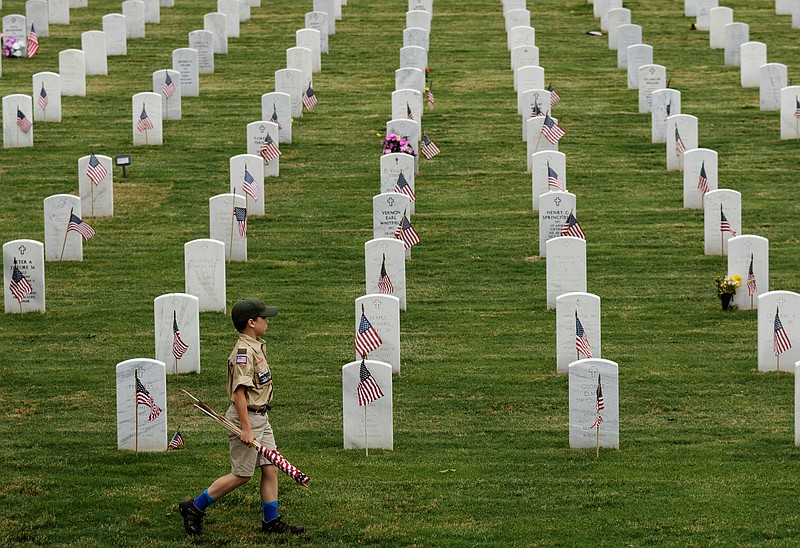Visitors who stroll the 121-acre grounds of the Chattanooga National Cemetery to pay tribute to loved ones today may take for granted the rolling expanse has always been as pristine as it is on this Memorial Day.
In fact, it has not been. And it took a group of local residents and a literal act of Congress 75 years ago to make sure it would be.
The local cemetery is administered by the Department of Veterans Affairs just as are 136 other national cemeteries in 40 states and Puerto Rico. The Department of the Army maintains two national cemeteries, and the Department of the Interior through the National Park Service maintains 14.
Of those maintained by the Department of the Interior, three are in Tennessee, including Fort Donelson in Dover, Shiloh National Cemetery in Shiloh and Stones River in Murfreesboro.
So why not Chattanooga? That's where the local effort came in.
In 1944, the cemetery was under the auspices of the Department of the Interior. But a group of members of the American Legion, Veterans of Foreign Wars and Chattanooga Chamber of Commerce demanded in a May meeting in the city courtroom that the "deplorable conditions" then extant at the cemetery required it to be transferred back to the then-War Department.
The War Department had been responsible for the cemetery until it was transferred to the Department of Interior under an executive order associated with President Franklin Roosevelt's 1933 Reorganization Act, according to newspaper archives.
Nevertheless, in the midst of World War II, according to the group, conditions had declined.
The citizens group told representatives of the National Park Service that there was a delay in burials; the grounds were being used "as a playground for children, race track for bicycles and cars, and rendezvous for lovers"; old graves and the grounds were being neglected; the cemetery had a lack of personnel and equipment; and administrators had failed to employ a night guard.
Photographic evidence of conditions, showing sunken graves and an inundated cemetery road among other things, was presented, according to the Chattanooga News-Free Press story by J.B. Collins, now 101, who still resides in East Lake.
"[W]ould you want the cemetery to be in this condition," asked Ross Daniels, spokesman for the local committee, "if your son" were buried there?
James H. Nichols, director of the Chamber of Commerce, was just as direct.
"I would rather see not another penny spent on national parks until conditions at [the Chattanooga] National Cemetery are corrected beyond reproach," he said, "for if the country owes anything to anyone, it owes a suitable resting place to those who fought for its preservation."
In response, a representative for the Department of the Interior said the department's budget in fact had been slashed over the past several years and that it lacked funds to make the changes the local group sought. But, he said, the machinery already had been set in motion for the transfer to the War Department, and he did not believe there would be any opposition.
Like most things with the federal government, it took time.
The measure effecting the transfer, sponsored by U.S. Rep. Estes Kefauver, D-Chattanooga, passed the House in September 1944. At the time, it was reported Tennessee Sens. Tom Stewart and Kenneth McKellar were working to shepherd it through the Senate.
With no C-SPAN to show Senate proceedings or 24-hour cable networks to report the news, the Dec. 7, 1944, passage of the bill did not reach Daniels until nearly a week after it occurred. Daniels had written Sen. Stewart on the day of the passage to inquire as to the cemetery's disposition.
Stewart, in his letter to Daniels, said the president had signed the bill, creating Public Law 470.
By the following Memorial Day, which was marked only days after the end of WWII hostilities in Europe, a photographic essay in the Chattanooga News-Free Press noted "veterans and families saw well-kept graves and conditions improved generally when they paid their respect to war dead" at the cemetery.
Another photograph showed Spanish-American War veterans, who had sponsored that year's Memorial Day service, paying tribute to their dead comrades.
"We are going to reorganize a world where all men will be free and equal," the Rev. J. Fred Johnson of First Cumberland Presbyterian Church said in the service's main address, "so that the boys who have lost their lives in this war may not have died in vain."
Seventy-five years later, sadly, not all men and women are free or equal. But those who continue to pay the price for such freedom are given the respect - thanks to the efforts of a local citizens group 75 years ago - of a beautiful and properly maintained national cemetery.
